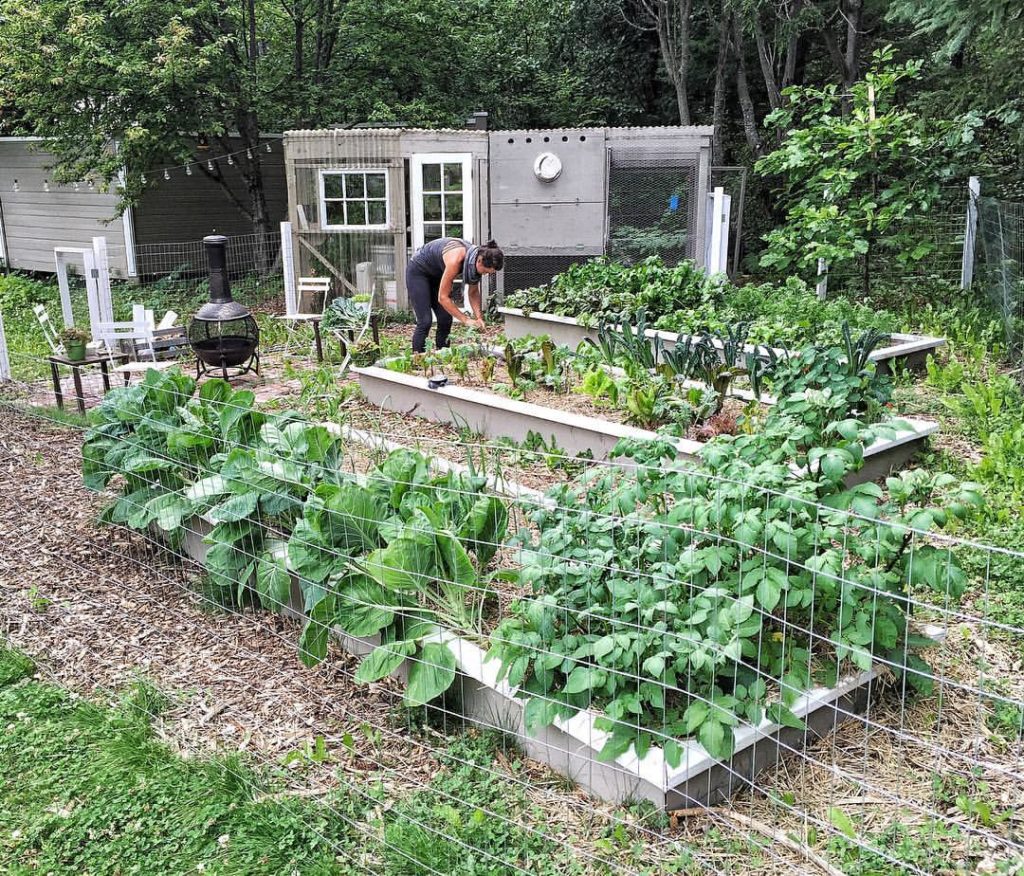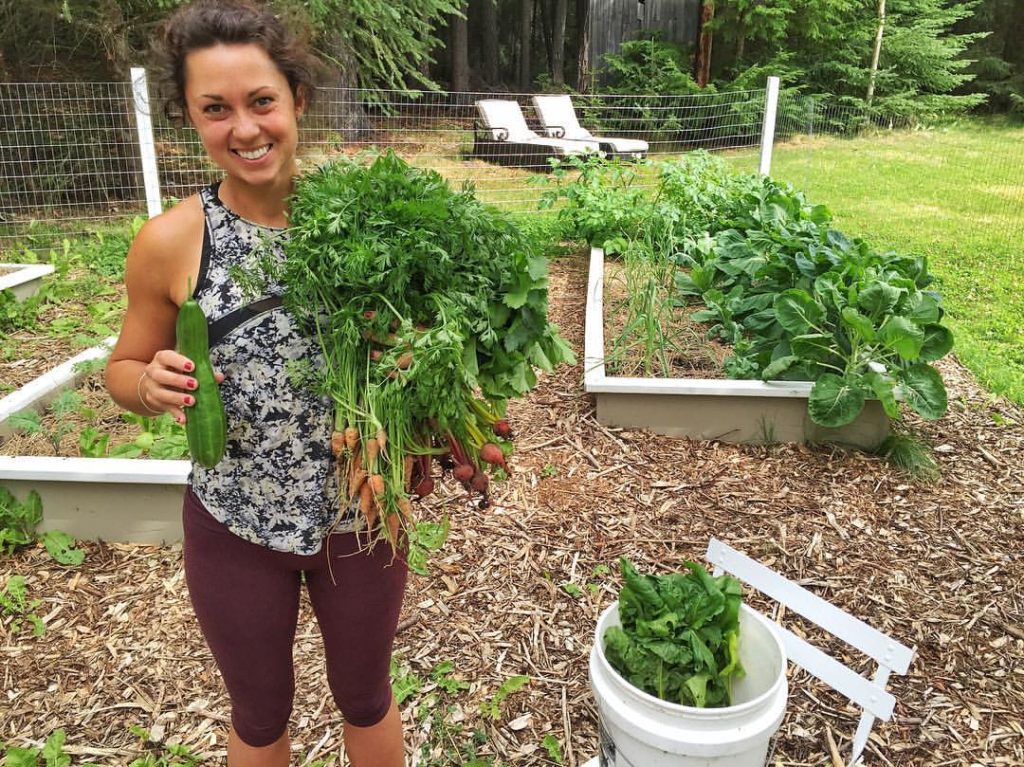This spring, I wrote about the benefits of starting a garden to supplement a freezer full of healthy proteins. The project felt like a second job for the first couple of months, building raised beds, filling them in with compost, pulling a fence to keep the backyard chickens out, developing a watering system, learning about fertilizing, transplanting, etc. It’s been enough work to replace a gym membership!
As with most things, the learning curve at the beginning felt steep. For a while there, we felt discouraged by every seedling that died, wondered if our brussel sprouts would ever grow, and doubted whether or not this whole thing had been worth it. Countless nights were spent poring over gardening books trying to understand why the zucchini leaves were yellowing, and why on earth our tomatoes wouldn’t flower!
Despite the initial investment of time, money, and a whole lot of sweat, I’m happy to report that our lasagna garden is now thriving! Our dinner decisions are now based almost entirely upon what is in the freezer and what needs to be harvested today. Having bags of blanched beet greens and frozen raspberries tucked away for the winter gives us a sense of good food security.
Here, I would like to share with you some of the key lessons we have learned in our first real season of gardening, and hope to inspire you to get out there and toss some seeds in the ground. The pioneers, explorers and adventurers we all admire and aspire to emulate were all competent foragers and growers of the foods they needed to survive. In my opinion it’s a skill any serious outdoorsman or woman should at least try their hand at!
1) Choose your growing medium wisely.
With our first three garden beds, we used a simple method of cultivation called lasagna gardening. To put it simply, we tossed everything we could scavenge, including a trailer load of goat manure, shredded paper, raked leaves, and food scraps into our garden beds. We began last October, and at the time it all looked more like trash heaps than garden beds. But, by the time May rolled around this spring, the earthworms and other decomposers magically transformed the pile of random junk into a nutritious garden bed. I had my doubts on whether or not everything had broken down enough to serve as a home for our seedlings, but by late June we had more lettuce than we could possibly eat!
In sharp contrast, feeling pretty confident about our green thumbs, we tore back another area of the yard and carted in a truck load or two of topsoil for a second garden. It looked great initially, and we were excited to see our squash cascading over the mounds we had built. Within a matter of a week, however, it became obvious that our squash were dying in this sterile environment. This garden bed was sorely lacking in organic matter, and simply didn’t retain moisture or provide enough nutrition for the little plants. To date, we have harvested only two zucchini from over fifteen struggling plants.
The take away? Don’t underestimate the importance of compost. By using the ingredients available to you in your own yard or home, you can likely put together a concoction of stuff that will provide far more nutrients for your plants than store-bought topsoil. I strongly encourage you to do a little research on lasagna gardening, and see if your grass clippings, leftover food, and leaf piles could become the perfect growing medium for your soon-to-be vegetables.
2) Don’t make your system overly complicated.
Being in Alaska, we were eager to give our vegetables a head start. In March, we planted five shelving units packed to the brim with seedlings: lettuce, peas, pumpkins, nasturtiums, tomatoes, kale, green beans, and herbs were suddenly bursting from the seedling trays, and before we knew it we had plants eager to move outdoors long before the soil had warmed up enough to transplant.
With some of our crops, however, we did wait until the soil temperature had reached fifty degrees before we dropped their seeds in the ground. Our carrots, beets, parsnips, and radishes were directly seeded in the pile of poop that was our raised beds, and by late July we had more beets than we knew what to do with, spending countless hours harvesting, blanching and freezing greens for the winter.
In hindsight, we shouldn’t have rushed things and could have simply waited to directly seed a lot more of our crops. These plants started off growing in their final destination and thrived. Instead of starting everything indoors and creating unnecessary steps of hardening off and transplanting, I encourage you to be patient, wait until the soil and air temperature is just right, and then start digging trenches for your seeds.
3) The golden rule: treat your plants as you would like to be treated.
Sometimes, it is easy to forget the simple things that we really need, like water, food, and shelter. Your plants are no different. If a cold front moves in, you want to consider creating some sort of shelter for your young plants. Row covers, or, in our case, makeshift greenhouses made of plastic bottles, will protect your plants from the environment.
Next, your plants need a constant supply of fresh water, just like you do. Developing a routine, like early-morning and late-evening watering, will set you up for success, rather than being reactionary and waiting until it’s too late to rehydrate. Plan ahead with your watering system (i.e. make water readily available at all times) and this will greatly reduce effort.
It’s important to remember that we also need regular feeding schedules. Much like you, your plants need a steady supply of nutrients to thrive. We have found that providing fish meal to our plants every two weeks has allowed them to flourish. Over-fertilizing is a whole different story, so don’t overdo it. Simply set a realistic schedule on the calendar and follow it. Your plants will love the regular supplementation with fish meal, bone meal, or an all-purpose fertilizer.
4) Exercise patience but know when to act!
I’m notoriously impatient, and when I don’t see consistent progress, I get discouraged and want to throw in the towel (or in this case, rip the stalling plants out of the ground and start new ones). Gardening has caused me to exercise my patience (and faith) muscles, and to simply give the crops more time rather than jump to the conclusion that they are doomed to fail. With your seeds, some may take up to three weeks to sprout, while others will come leaping out of the ground like our little radishes. The entire act of gardening will help teach you the lesson of patience like nothing else.
With that said, when something is ready to be harvested, you need to act! We had countless heads of lettuce go to seed, simply because we weren’t harvesting often enough. We also had plants that overgrew their containers, meaning we had missed the window of opportunity to transplant them. There may not be a lot you can do each day in your garden, but when something needs to be done, like picking the basil and making a big batch of pesto before it flowers, you need to carve an hour out of your day and get to work!
This is all coming from a very novice gardener who looks forward to becoming a master over the next few decades, but I encourage you to get out there and get some dirt under your fingernails. There isn’t much that is more gratifying than whipping up a meal comprised of a salmon you caught or a moose roast from last season paired with a large green salad of lettuce, kale, nasturtiums, and peas that you spent months cultivating. Make those mountain men and women of years gone by proud!
Happy gardening!
About the Author:
Heather Kelly is the creator of Heather’s Choice Meals for Adventuring. Inspired by her personal backcountry trips, Heather strives to create healthy, delicious meals and snacks for folks headed out on epic adventures. You can order her meals and snacks online at heatherschoice.com and use the coupon code JOMH to save 10% off your next order.





